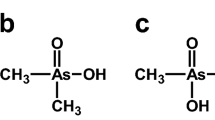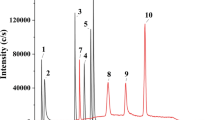Abstract
In this study, we employed liquid chromatography–inductively coupled plasma mass spectrometry (LC–ICP-MS) to explore bromine bioforms in human serum. Three bromine species were found by size exclusion chromatography–inductively coupled plasma mass spectrometry (SEC–ICP-MS), and one of the most abundant species was identified as Br− by anion exchange chromatography–inductively coupled plasma mass spectrometry (IC–ICP-MS).The quantitative detection of Br− was performed by SEC–ICP-MS, and the total bromine was detected by ICP-MS. Results for the determination of Br− and total bromine in human serum revealed that Br− is the major form of bromine in human serum, with a ratio ranging from 57.3 to 68.8%. Furthermore, we developed a method for the determination of ambroxol based on reversed phase high-performance liquid chromatography–inductively coupled plasma mass spectrometry (RP-HPLC–ICP-MS), and then applied it in rat plasma analysis. After optimization of the RP-HPLC–ICP-MS parameters and pre-treatment procedures, the retention time of ambroxol was 4.6 min and the detection limit was 7.0 μg L−1. The average recovery was 85.4%, with relative standard deviation of 8.4%. The above results showed that the RP-HPLC–ICP-MS method possessed the advantages of low matrix interference and time efficiency, which were better than those reported for traditional RP-HPLC methods. Therefore, this new method for the detection of ambroxol based on RP-HPLC–ICP-MS was certainly a good tool for ambroxol analysis.
Graphical abstract





Similar content being viewed by others
References
Underwood EJ (1977) Trace elements in human and animal nutrition. Academic Press, Inc., New York, p 1977
Bumbalova A, Havranek E, Harangozo M, Riecanska E, Dejmkova E (1991) Multielement XRF-analysis of blood from patients with dilated cardiomyopathy. J Radioanal Nucl Ch 153(4):257–265
Yanagisawa I, Yoshikawa H (1968) Micro-determination of bromine in cerebrospinal fluid. Clin Chim Acta 21(2):217–224
Yanagisawa I, Yoshikawa H (1973) A bromine compound isolated from human cerebrospinal fluid. BBA Bioenergentics 329(2):283–294
McCall AS, Cumming CF, Bhave G, Vanacore R, Page-McCaw A, Hudson BG (2014) Bromine is an essential trace element for assembly of collagen IV scaffolds in tissue development and architecture. Cell 157:1380–1392
Cuenca RE, Pories WJ, Bray J (1988) Bromine levels in human serum, urine, hair. Biol Trace Elem Res 16:151–154
Alaffi ZB, Lave N (1983) Determination of bromine in blood serum by epithermal neutron activation analysis. Anal Chem 55:796–797
Yap CT (1988) X-ray total reflection fluorescence analysis of iron, copper, zinc, and bromine in human serum. Appl Spectrosc 42(7):1250–1253
Muller M, Reinhold P, Lange M, Zeise M, Jurgens U, Hallier E (1999) Photometric determination of human serum bromide levels-a convenient biomonitoring parameter for methyl bromide exposure. Toxicol Lett 107:155–159
Ceko MJ, Hummitzsch K, Hatzirodos N, Bonner W, James SA, Kirby JK, Rodgers RJ, Harris HH (2015) Distribution and speciation of bromine in mammalian tissue and fluids by X-ray fluorescence imaging and X-ray absorption spectroscopy. Metallomics 7:756–765
Yang HC, Nguyen PAA, Islam M, Huang CW, Poly TN, Iqbal U, Li YCJ (2018) Gout drugs use and risk of cancer: a case-control study. Joint Bone Spine 85:747–753
Seo EJ, Sugimoto Y, Greten HJ, Efferth T (2018) Repurposing of bromocriptine for cancer therapy. Front Pharmacol 9:1–15
Gillissen A, Nowak D (1998) Characterization of N-acetylcysteine and ambroxol in anti-oxidant therapy. Resp Med 92:609–625
Saleh OA, Yehia AM, El-Azzouny AAS, Aboul-Enein HY (2015) A validated chromatographic method for simultaneous determination of guaifenesin enantiomers and ambroxol HCl in pharmaceutical formulation. RSC Adv 5:93749–93756
Goswami JA, Shah NJ (2018) Stability indicating RP–HPLC method for combination of ambroxol hydrochloride and levofloxacin hemihydrate in pharmaceutical formulation. Int J Pharm Sci Res 9(12):5197–5203
Zang QC, Liu Y, He JM, Yue XF, Zhang RP, Wang RX, Abliz Z (2015) A sensitive and rapid HPLC–MS/MS method for the quantitative determination of trace amount of bromocriptine in small clinical prolactinoma tissue. J Chromatogr B 989:91–97
Dong X, Ding L, Cao XM, Jiang LY, Zhong SS (2013) A sensitive LC–MS/MS method for simultaneous determination of amoxicillin and ambroxol in human plasma with segmental monitoring. Biomed Chromatogr 27:520–526
De-Vries JX, Walter-Sack I, Ittensohn A (1987) Analysis of benzbromarone in human plasma and urine by high performance liquid chromatography and gas chromatography-mass spectrometry. J Chromatogr B 417:420–427
Guo ZN, Chen YS, Ding XL, Huang CR, Miao LY (2016) Simultaneous determination of ambroxol and salbutamol in human plasma by ultra-performance liquid chromatography-tandem mass spectrometry and its application to a pharmacokinetic study. Biomed Chromatogr 30:1789–1795
Klencsar B, Sanchez C, Balcaen L, Todoli J, Lynen F, Vanhaecke F (2018) Comparative evaluation of ICP sample introduction systems to be used in the metabolite profiling of chlorine-containing pharmaceuticals via HPLC–ICP–MS. J Pharm Biomed Anal 153:135–144
Heitland P, Blohm M, Breuer C, Brinkert F, Achilles EG, Pukite L, Koster HD (2017) Application of ICP–MS and HPLC–ICP–MS for diagnosis and therapy of a severe intoxication with hexavalent chromium and inorganic arsenic. J Trace Elem Med Bio 41:36–40
Liu LJ, Li XW, Wang HY, Cao XX, Ma W (2017) Reduction of iodate in iodated salt to iodide during cooking with iodine as measured by and improved HPLC/ICP-MS method. J Nutr Biochem 42:95–100
Zhu SQ, Chen BB, He M, Huang T, Hu B (2017) Speciation of mercury in water and fish samples by HPLC–ICP–MS after magnetic solid phase extraction. Talanta 171:213–219
Gao YC, Yang C, Ma J, Yin MX (2018) Characteristics of the trace elements and arsenic, iodine and bromine species in snow in east-central China. Atmos Environ 174:43–53
Romaris-Hortas V, Bermejo-Barrera P, Moreda-Pineiro J, Moreda-Pineiro A (2012) Specaiton of the bio-available iodine and bromine forms in edible seaweed by high performance liquid chromatography hyphenated with inductively coupled plasma-mass spectrometry. Anal Chim Acta 745:24–32
Shi HL, Adams C (2009) Rapid IC–ICP/MS method for simultaneous analysis of iodoacetic acids, bromoacetic acids, bromated, and other related halogenated compounds in water. Talanta 79(2):523–527
Balcaen LIL, De Samber B, De Wolf K, Cuyckens F, Vanhaecke F (2007) Hyphenation of reverse-phase HPLC and ICP–MS for metabolite profiling-application to a novel antituberculosis compound as a case study. Anal Bioanal Chem 389(3):777–786
Cuyckens F, Balcaen LIL, De Wolf K, De Samber B, Van Looveren C, Hurkmans R, Vanhaecke F (2008) Use of the bromine isotope ratio in HPLC–ICP–MS and HPLC–ESI–MS analysis of a new drug in development. Anal Bioanal Chem 390(7):1717–1729
Smith CJ, Shillingford S, Edge AM, Bailey C, Wilson ID (2008) Quantification of the in vitro and in vivo metabolic fates of 2-, 3- and 4-bromobenzoic acids using high temperature LC coupled to ICP–MS and linear ion trap MS. Chromatographia 67(9–10):673–678
Meermann B, Bockx M, Laenen A, Van Looveren C, Cuyckens F, Vanhaecke F (2012) Speciation analysis of bromine-containing drug metabolites in feces samples from a human in vivo study by means of HPLC/ICP–MS combined with on-line isotope dilution. Anal Bioanal Chem 402(1):439–448
Meermann B, Hulstaert A, Laenen A, Van Looveren C, Vliegen M, Cuyckeds F, Vanhaecke F (2012) HPLC/ICP–MS in combination with “reverse” online isotope dilution in drug metabolism studies. Anal Chem 84(5):2395–2401
Quinones O, Snyder SA, Cotruvo JA, Fisher JW (2006) Analysis of bromate and bromide in blood. Toxicology 221(2–3):229–234
Lyon TDB, Robin PA, Watson WS, Littlejohn D (2005) Determination of elevated concentrations of bromine in serum by ICP–MS and ICP–OES. J Anal At Spectrom 20:757–759
Kim H, Yoo JY, Han SB, Lee HJ, Lee YR (2003) Determination of ambroxol in human plasma using LC–MS/MS. J Pharm Biomed Anal 32:209–216
Su FL, Wang F, Gao W, Li HD (2007) Determination of ambroxol in human plasma by high performance liquid chromatography-electrospray ionization mass spectrometry. J Chromatogr B 853:364–368
Pechancova R, Plhacek T, Gallo J, Milde D (2018) Study of chromium species release from metal implants in blood and joint effusion: utilization of HPLC–ICP–MS. Talanta 185:370–377
Michalke B, Witte H (2015) Characterization of a rapid and reliable method for iodide biomonitoring in serum and urine based on ion chromatography-ICP-mass spectrometry. J Trace Elem Med Bio 29:63–68
Jagtap R, Maher W, Krikowa F et al (2016) Measurement of selenomethionine and selenocysteine in fish tissues using HPLC–ICP–MS. Microchem J 128:248–267
Jitaru P, Goenaga-Infante H, Vaslin-Reimann S et al (2010) A systematic approach to the accurate quantification of selenium in serum selenoalbumin by HPLC–ICP–MS. Anal Chim Acta 657:100–107
Acknowledgements
We gratefully acknowledge the financial support from the Jiangsu Provincial Medical Youth Talent (QNRC2016540), and the Key Project and Open Research Fund of State Key Laboratory of Bioelectronics, Southeast University. This study was also supported by the Jiangsu Provincial Commission of Health (CXTDB2017012), the National Natural Science Foundation of China (NSFC91743205, NSFC81773479), and the Jiangsu Social Development Project (BE2018745).
Author information
Authors and Affiliations
Corresponding authors
Ethics declarations
Conflict of interest
The authors declare that they have no competing interests.
Ethical approval
All biological sample experiments in this study were carried out in accordance with institutional and national guidelines for the care and use of human serum and laboratory animals. The human serum experiment was a project of the Chinese National Bio-monitoring, and the ethical review was approved by the National Institute of Environmental Health, Chinese Center for Disease Control and Prevention, No. 201814. The ethical review of the in vitro and in vivo rat plasma experiments was approved by the Jiangsu Center for Disease Control and Prevention, No. 2018013.
Additional information
Publisher's Note
Springer Nature remains neutral with regard to jurisdictional claims in published maps and institutional affiliations.
Rights and permissions
About this article
Cite this article
Liu, D., Chen, G., Huo, Z. et al. A Study of Bromine Speciation in Human Serum and Ambroxol Determination in Rat Plasma by Liquid Chromatography–Inductively Coupled Plasma Mass Spectrometry. Chromatographia 82, 927–934 (2019). https://doi.org/10.1007/s10337-019-03730-z
Received:
Revised:
Accepted:
Published:
Issue Date:
DOI: https://doi.org/10.1007/s10337-019-03730-z




